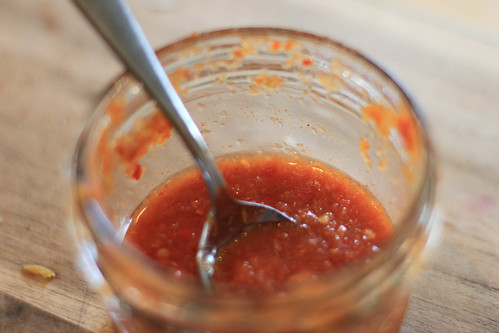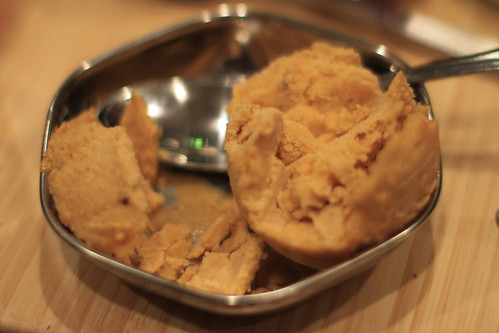
Malawi's a landlocked country in southern Africa, hugging the lake with which it shares a name. And Laura's sister's husband just so happened to do Peace Corps there, so Scott provided some enthusiastic and thorough advice on what to cook.
Joining us for the meal were Brett, Kaely, Lisa, Audrey, Elizabeth, Amy, and Jérémy and his French companions.
Nali sauce

Probably the single food item that other Africans will recognize from Malawi is this notoriously spicy chili sauce. While there's a site in Australia that seemed to be the only way to get it shipped to the US, they were completely out of stock when I checked before the meal. So, I had no alternative but to try it on my own, and to help me with this, Scott shared the ingredients and a description:
"Ingredients: water, birds-eye chilies, fresh paprika, onions, acetic acid, garlic, salt, stabilizer (E415), antioxidant (E300), preservative (E211).
It's quite simple. It doesn't come off as vinegar based despite the acetic acid... very heavy on the paprika and onion. No oil-- that would be more of a west african Piri Piri, at least in my experience. Out of the bottle it flows but is still a bit chunky."
So into the blender I threw these ingredients, minus the preservatives, and used dried paprika instead of what was probably meant to be bell pepper. To keep things easy (and spicy!) I used a whole pack of frozen Thai chilies, seeds and all. I regret not taking down the proportions, because the result was quite tasty, spicy for sure but with some body from the onions.
Fish and chips

As Scott describes: "at all markets and bus stands you will find chippies, which are thick cut potatoes fried in low grade vegetable oil in a freestanding, flat-topped fryer. These are the best thing ever, sprinkled with caked salt, chili powder, and fresh minced cabbage with vinegar. Man I am getting hungry." I couldn't stomach getting the actually cheapest oil I could find, but I did go with good old Wesson. Armed with a really puny french-fry slicer I got for a quarter at a yard sale, a sack of Russets, and a wok, I did my best version of roadside stand chips, complete with toppings. Very tasty.
Along with that I simply fried some tilapia filets, the closest thing I could find to chambo, a popular fish from Lake Malawi. On its own, plain fried tilapia is decent, but with some Nali sauce and the potatoes, all generously doused in vinegary shredded cabbage, it was a darn good snack.
Nsima | Cornmeal mush

Again, Scott: "The key is getting the nsima just right. It is typically cooked over an open fire and takes some serious arm strength-- constant stirring for 10-20 minutes at a full boil as it thickens. It's all basic food but challenging to get right." The best cornmeal to use is masa intended for tortillas, and just like other African mushes, you start by boiling water and then adding the grain until it's the right thickness. Nsima makes for the huge proportion of most Malawian meals.
Ndiwo | Vegetable stew | Recipe

As an indication of the primacy of the nsima, the vegetables typically served with it are generally referred to as "relish" in English. That is, they're there more to give flavor to the mush than as a substantial element of the meal. It's pretty much any green you can find — pumpkin greens are apparently the most common but it seems that almost any cookable leaf would work — sauteed and simmered with onion and tomato.
Beans | Recipe

Several sources, including Scott, rave about the quality of the beans in Malawi. It's unclear whether the beans themselves are so tasty, or if it's more about how they're prepared, but I gave it my best shot, and indeed they were quite flavorful. What's most distinctive about this technique is that the beans aren't drained, but rather cooked in a relatively small amount of water which then becomes a rich sauce once vegetables are added. My only variation on the recipe was to use vegetable oil, which surely is more authentic to the region than the specified olive oil.
Sweet potato ice cream | Recipe

The only thing this has to do with Malawi is featured ingredient. Dairy is rare in Malawi and refrigeration even less common. But I'd just gotten the machine and we were in a heat wave, so I took some creative license. It tasted like Christmas with cinnamon and nutmeg, and had a bit of graininess to it which was surprisingly pleasant.